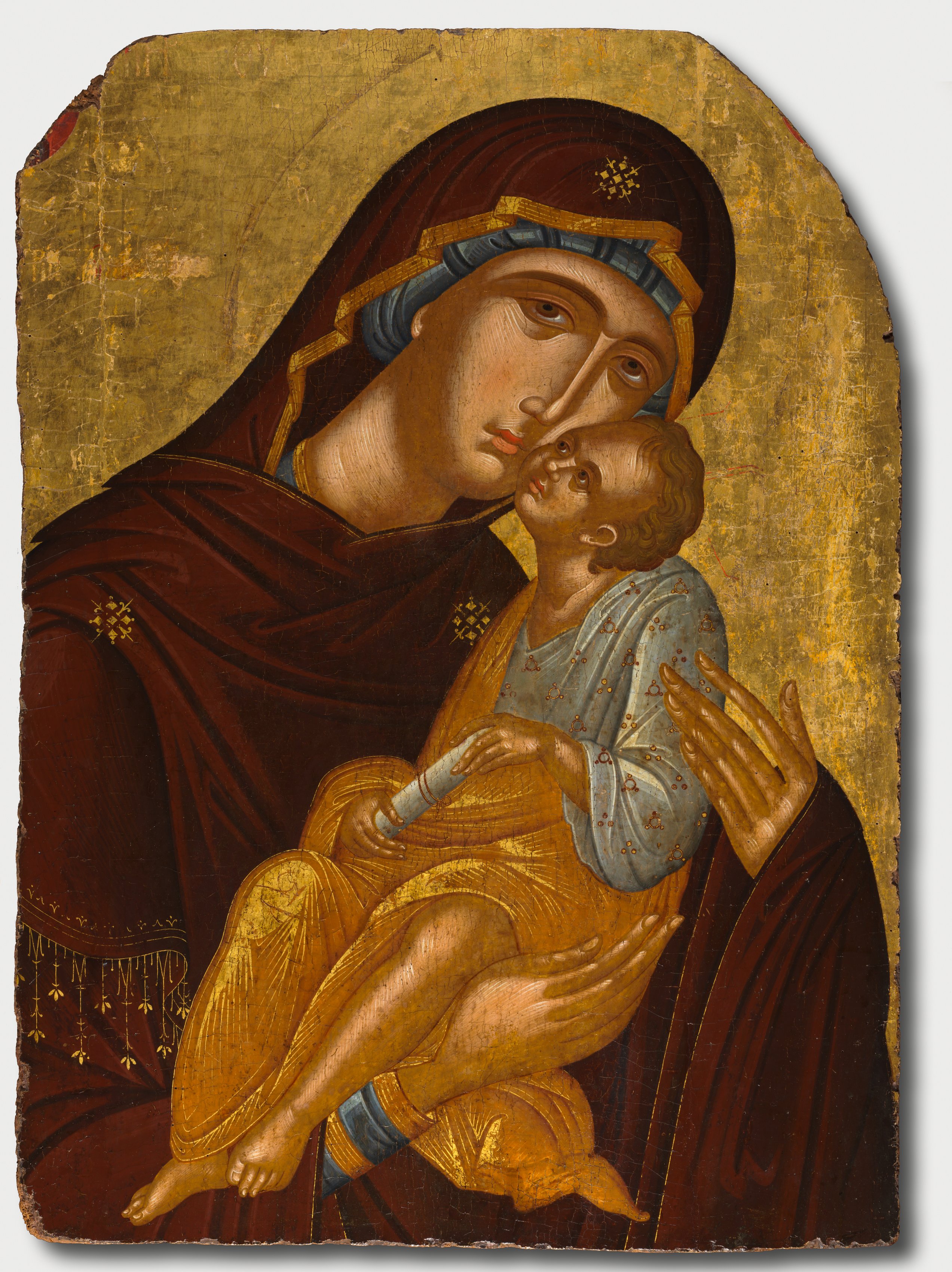The Cleveland Museum of Art
Collection Online as of April 17, 2024

Icon of the Mother of God and Infant Christ (Virgin Eleousa)
c. 1425–50
attributed to Angelos Akotantos
(Greek, d. 1450)
Unframed: 96 x 70 cm (37 13/16 x 27 9/16 in.)
Leonard C. Hanna, Jr. Fund 2010.154
Location: 003 Special Exhibition Hall
Did You Know?
This is the only known work by Angelos Akotantos in the United States.Description
This large icon of a tender embrace between the Virgin Mary and Christ likely hung on a Greek Orthodox church’s iconostasis, a screen separating the congregation from the altar-containing sanctuary, which only clergy could enter. A skilled painter of faces and draperies, Angelos Akotantos was among Crete’s most sought-after artists. Based in Byzantium’s artistic center in his hometown of Candia, he painted for imperial clients and beyond. Despite theological differences, Cretan icons of Mary were popular in Ethiopia. In the early 1500s, Emperor Lebna Dengel sent monks Zekre and Pawli to acquire Cretan icons for him. Twenty-nine Cretan icons are still venerated (honored) in Ethiopian churches.- Materials and techniques used to create this icon are consistent with other icons attributed to Angelos Akotantos. In this case, three planks of wood were affixed together with long iron spikes. The X-ray reveals that two iron spikes, driven through the right plank, were removed during a previous intervention, leaving only the tips of each spike lodged within the central plank. Wide strips of an open-weave canvas were applied over the wood joins to prevent cracking of the subsequent applications of gesso, egg tempera, and gold leaf. A thick gesso layer, composed of gypsum and animal glue, was then applied over top of the wood panel and strips of canvas. Before the application of the egg tempera and gold leaf, fine incised lines were cut into the gesso layer as guides for the initial placement of the Virgin Eleousa and infant Christ. Further refinement to the faces, hands, and draperies was executed with fine painted lines, visible in the infrared reflectogram (IRR). Next, thin layers of red bole (red clay bound in hide glue) were applied to the gesso around the figures. Gold was then applied to the bole with water gilding. Next, egg tempera paint was applied over the drawing with traditional layering techniques, using fine strokes to create volume and shading. Finally, gold leaf embellishments to the clothing of the Virgin Eleousa and infant Christ were applied with a mordant (oil) gilding technique. The original format was most likely rectangular. Approximately 8 centimeters have been trimmed from the outside edge of the left plank, possibly to cut away damage from worm tunneling. The arch shape of the upper right appears to have been intentionally trimmed, possibly to fit into a curved niche. Immediately after the acquisition in 2010, the icon underwent a yearlong technical study and conservation treatment to stabilize the gesso and paint layers and to remove areas of discolored retouching and regilding over the gold background. A vertical buckle in the original canvas was reattached to the wood substrate. Areas of loss in the ground and paint layers were filled and leveled with a gypsum and calcium carbonate mixture, formulated to be compatible with physical and chemical properties of the original gesso. After filling, losses in the paint layer were inpainted (retouched) with powdered pigments ground in aldehyde resin, using a technique in which fine vertical lines are used to create a chromatic vibration. A final natural resin varnish (dammar) was thinly applied only over painted areas, leaving the gold unvarnished. Worn passages of the gold background were inpainted with powdered pigments in aldehyde resin with the addition of gold powder.
- 1989[Antonio de Crescenzo and Co., Rome, March 15, 1989]1989-2010Private collection, Rome, sold to the Cleveland Museum of Art2010-The Cleveland Museum of Art, Cleveland, OH
- Auction Catalogue of Antonio de Crescenzo and Co., Via Virginio Orsini, Rome, Sale March 15, 1989.Baltoyanni, Chrysanthi. Icons: Mother of God. Athens: Adam Editions, 1994. p. 24Cleveland Museum of Art, "Cleveland Museum of Art Announces Newest Acquisitions," September 7, 2010, Cleveland Museum of Art Archives. archive.orgCleveland Museum of Art. Cleveland Art: The Cleveland Museum of Art Members Magazine. Vol. 53 no. 05, September/October 2013 Mentioned & reproduced: p. 13 archive.orgProlović, Jadranka. Resava (Manasija): Geschichte, Architketur und Malerei einer Stiftung des serbischen Despoten Stefan Lazarević. 2017. p. 713 Reproduced: P. 713, Abb. 361"Performing Arts: Antennae. Aleksandra Vrebalov's Byzantine-inspired music resonates like a human tuning fork.” Cleveland Art: Cleveland Museum of Art Members Magazine 60, no. 2 (March/April 2020): 36-37. Reproduced: P. 37; Mentioned: P. 36, 37.Liebert, Emily, Nadiah Fellah, and William Griswold. Picturing Motherhood Now. Cleveland : Cleveland Museum of Art, 2021. Mentioned & Reproduced: P. 10-11, fig. 1Cleveland Museum of Art. The CMA Companion: A Guide to the Cleveland Museum of Art. Cleveland: Cleveland Museum of Art, 2014. Mentioned and reproduced: P. 262Gertsman, Elina, and Stephen N. Fliegel. Collectors, Commissioners, Curators: Studies in Medieval Art for Stephen N. Fliegel. Berlin ; Boston : De Gruyter ; [Kalamazoo, Michigan] : Medieval Institute Publications, 2023. Mentioned and reproduced: pp. 4-5, Fig. 0.2.
- Africa & Byzantium. The Cleveland Museum of Art, Cleveland, OH (co-organizer) (April 14-July 21, 2024).
- {{cite web|title=Icon of the Mother of God and Infant Christ (Virgin Eleousa)|url=false|author=Angelos Akotantos|year=c. 1425–50|access-date=17 April 2024|publisher=Cleveland Museum of Art}}
Source URL:
https://www.clevelandart.org/art/2010.154